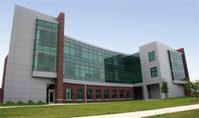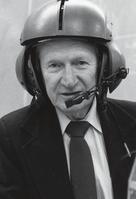September 2006
This is a very special time for all of us at the Weldon School of Biomedical Engineering. Our first group of undergraduate students has entered their senior year, and they do so in a new location on campus.
We moved into our new and innovative research and education facility dedicated to biomedical engineering. Staff, students, and faculty have undertaken a labor of love to shape the Biomedical Engineering Building into our Schools home. I hope you will enjoy reading about the building, and also about a special surprise tribute to honor a pioneer of our field and the heart of biomedical engineering in the Weldon School: Prof. Leslie A. Geddes.
On behalf of everyone here at the Weldon School, I hope that you will join us for our building dedication on September 22. For those unable to attend in person, you can check our blog (http://weldonbme.org) for information on live streaming of the events, as well as other news of interest.
We look forward to having you join us as we dedicate the future of biomedical engineering research and education, and honor a man who is the cornerstone of the foundation upon which we all are building the future.
Best regards,
George Wodicka

The worlds of science, medicine, and education are changing in profound and powerful ways. Academic disciplines long held separate are finding rich opportunities for collaboration, and industry is working to translate the results into products that will revolutionize medicine and healthcare. Educating tomorrow's researchers and leaders who will make this reality requires new, innovative strategies and facilities.
On September 22, an innovative campus environment for interdisciplinary research and teaching, the new $25 million Biomedical Engineering building, will be dedicated. This flagship facility is the result of an unparalleled collaboration between the architects, the faculty, researchers, and students to optimize both the design and the design process for excellence. The unique and innovative facility also serves as the academic gateway to Purdue's Discovery Park. Key buildings within walking distance include:
The internal design is focused on the future. The proximity of multi-sized classrooms, instructional laboratories, team-based project rooms, counseling areas, and informal interaction spaces creates a unique learning environment and encourages an integrated and fluid movement of people, activities, and ideas. Designers worked with faculty researchers and staff members to ensure that all resources needed, from consumables to appropriate electrical power supply, were readily and safely accessible. In areas where a need for continual adaptation is expected provisions were made to allow quick modifications to meet future needs of interpersonal interactions to technology changes.
Special care was also taken in the design of the research spaces. The research labs are clustered along thematic lines for flexibility and synergy, and incorporate a number of special features. One example of this are the specialized optics labs, which are build on their own individual concrete slabs in the basement, isolating them from vibrations that could affect measurements.
A good example of internal connectivity is found in the central instructional laboratory complex. Contained in this interconnected complex are a wet–bench laboratory (cell and tissue biology), an instrumentation laboratory (mechanical and electrical testing), a tissue culture facility, and a microscope darkroom (light and fluorescence). A central prep room and instructional coordinator's office link the multi-faceted learning activities scheduled for all levels of undergraduate laboratories.
"The need for biomedical engineers in industry, healthcare environments, as well as academia will continue to grow," states George Wodicka, head of the Weldon School of Biomedical Engineering at Purdue University. "We are increasing our instructional and applied research capacity to meet future demand. Our graduate program has doubled in size from 40 to more than 80 students, our first class of undergraduates has entered their senior year, and we now have 15 primary faculty members and will add 10 more in the next two years. This will allow us to graduate about 75 undergraduates and 25 graduate students each year."
The building is jointly funded by the State of Indiana and private donations. The General Assembly authorized Purdue to issue bonds to cover $13 million, and private donations, including a special $5 million grant from the Whitaker Foundation, provided the remaining $12 million. The late Governor Frank O'Bannon was a strong supporter of the School, and will be honored with a plaque at the entrance for his instrumental role in securing state funding for the building.

On September 22, colleagues, former students, and friends will gather to honor the man who is the heart of biomedical engineering at Purdue, and whose work and innovations are a cornerstone for biomedical engineering research and education worldwide. Prof. Leslie A. Geddes, the Showalter Distinguished Professor Emeritus of Biomedical Engineering, is responsible for innovations ranging from burn treatments to implantable defibrillators, ligament repair to special blood pressure monitors for premature infants; and, most of all, for shaping biomedical engineering education to produce the leaders of today and of the future.
Prof. Dr. Geddes founded biomedical engineering at Purdue when he and a team from Baylor University came here in 1974 to open what became the Hillenbrand Biomedical Engineering Center. While he officially retired as Center Director in 1991, the 85–year–old Geddes continues both research and educational activities, arriving at 4:30 am every morning.
Those speaking at this surprise event include:
- John DeFord, a Purdue alumnus and vice president of science and technology at C. R. Bard Inc.
- Willis A. Tacker, Purdue professor in the Department of Basic Medical Sciences.
- Earl Bakken, founder of Medtronic Inc. (via video)
- Huntly Millar, founder of Houston–based Millar Instruments Inc.
- Norman Weldon, an alumnus and entrepreneur whose family committed $10 million toward Purdue's biomedical engineering program.
On behalf of Dr. George Wodicka and the faculty, staff, and students of the Weldon School of Biomedical Engineering, you are cordially invited to attend the dedication of the Biomedical Engineering Building and the Surprise Symposium for Dr. Leslie A. Geddes. The building dedication will begin at 10:30 on September 22nd with participants including Dr. Peter G. Katona, Past President and CEO of The Whitaker Foundation. The symposium will follow at 1:30 that day.
Itinerary:
10:30 a.m. Dedication of the Biomedical Engineering Building
11:00 a.m. Building Tours
11:30 a.m. College of Engineering Dean's Club Luncheon
1:30 p.m. Surprise Symposium in honor of Dr. Leslie A. Geddes
(Reception immediately following the symposium.)
All events will take place at:
Biomedical Engineering Building
206 South Intramural Drive
West Lafayette, IN 47907–1791
(Parking available at Harrison Street and Intramural Drive lot.)
Please RSVP to the following:
Brian Knoy
bjknoy@purdue.edu
765 494–6241



